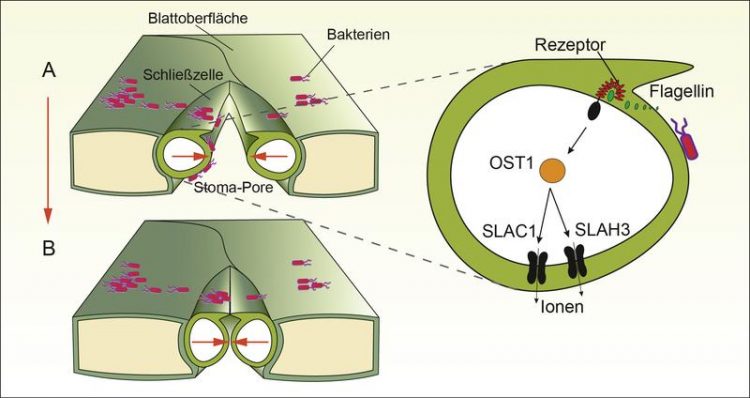How Plants isolate themselves against Bacteria

Bacteria use open pores in order to get into the inside of the leave (A). If the plant notices the bacterial flagellin, the OST1 enzyme activates the ion channels SLAC1 and SLAH3, and the pores close (Graphics: Rob Roelfsema)
Plants are continuously besieged by viruses, fungi and bacteria. This is the reason why immune responses have developed in the course of evolution with which they defend themselves against many pathogenic microorganisms. An international research team has now analysed an immune response which complicates the penetration of bacteria into the leaves.
There are many very small pores in the leaves that can open wide or close completely. Through these holes in their skin, plants regulate the vital exchange of air and water with the environment. However, the pores also harbour a risk: They are welcome loopholes for pathogenic bacteria through which they can enter into the plant.
What happens in the event of a bacterial infection on the leave pores, the stomata, has so far been virtually unknown. An international research team has just published new findings about this issue in the “New Phytologist” journal. The plant scientists Rainer Hedrich and Rob Roelfsema from the University of Würzburg form the core of the team. The molecular mechanisms for controlling the stomata have been their focus for many years in their study groups.
Injecting the bacterial protein flagellin into leaves
How do stomata respond to an infestation of bacteria? This is what Aysin Guzel Deger, currently a guest PhD student at the University of Würzburg, from the University of Mersin (Turkey), wanted to find out.
For this, she injected the bacterial protein flagellin into the leaves of the model plant Arabidopsis (Arabidopsis thaliana). This protein occurs in many bacteria. The plants obviously consider it dangerous and as a result respond very quickly: About 15 minutes after the injection they start to close their stomata. This is how they block the entry path of the bacteria.
The flagellin develops its effect on the guard cells which limit the stomata of the plant: Each leaf pore is lined by two cells and they ensure that the pore size can be changed. In cooperation with a team from Estonia, the Würzburg team found out exactly where the flagellin has an effect on the guard cells: “Through the OST1 enzyme it activates the ion channels SLAC1 and SLAH3. As a result the guard cells go limp and the pores close”, explains Roelfsema.
Flagellin activates the dry stress signal path
Interestingly, the enzyme and the two ion channels are also contributors when plants close their pores in the event of dryness. This way they reduce the loss of water to the environment, as Hedrich’s team already found out quite a while ago.
Dryness and bacterial pathogens therefore activate the same signal path in plants: In plant cultivation, this new finding could be used to catch two birds with one stone: “Cultivated plants with improved OST1 enzymes may at the same time be more resistant against dryness and against bacteria, says professor Hedrich. For farming, this is an exciting perspective, because dryness and pests are among the main factors that contribute to worldwide crop losses.
“Guard cell SLAC1-type anion channels mediate flagellin-induced stomatal closure”, Aysin Guzel Deger, Sönke Scherzer, Maris Nuhkat, Justyna Kedzierska, Hannes Kollist, Mikael Brosché, Serpil Unyayar, Marie Boudsocq, Rainer Hedrich, and M. Rob G. Roelfsema. New Phytologist, published online on 30 April 2015, DOI: 10.1111/nph.13435
Contact
Prof. Dr. Rainer Hedrich, Department of Botany I (Molecular Plant Physiology and Biophysics) of the University of Würzburg, T (0931) 31-86100, hedrich@botanik.uni-wuerzburg.de
PD Dr. Rob Roelfsema, Department of Botany I (Molecular Plant Physiology and Biophysics) of the University of Würzburg, T (0931) 31-86121, roelfsema@botanik.uni-wuerzburg.de
Media Contact
More Information:
http://www.uni-wuerzburg.deAll latest news from the category: Life Sciences and Chemistry
Articles and reports from the Life Sciences and chemistry area deal with applied and basic research into modern biology, chemistry and human medicine.
Valuable information can be found on a range of life sciences fields including bacteriology, biochemistry, bionics, bioinformatics, biophysics, biotechnology, genetics, geobotany, human biology, marine biology, microbiology, molecular biology, cellular biology, zoology, bioinorganic chemistry, microchemistry and environmental chemistry.
Newest articles

Combatting disruptive ‘noise’ in quantum communication
In a significant milestone for quantum communication technology, an experiment has demonstrated how networks can be leveraged to combat disruptive ‘noise’ in quantum communications. The international effort led by researchers…

Stretchable quantum dot display
Intrinsically stretchable quantum dot-based light-emitting diodes achieved record-breaking performance. A team of South Korean scientists led by Professor KIM Dae-Hyeong of the Center for Nanoparticle Research within the Institute for…

Internet can achieve quantum speed with light saved as sound
Researchers at the University of Copenhagen’s Niels Bohr Institute have developed a new way to create quantum memory: A small drum can store data sent with light in its sonic…





















